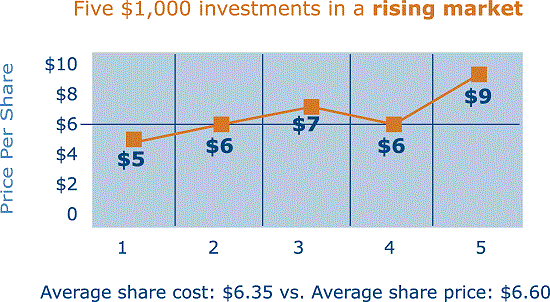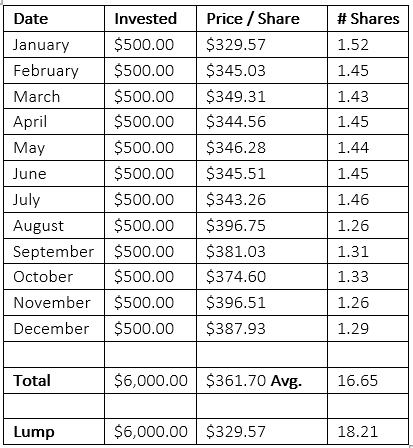 Dollar cost averaging is simply the act of making like dollar investments on a periodic basis, say every month or every quarter. It is sold as a technique because they want you to believe that no one can outperform the market. There are many papers written on this subject and I don’t want to dwell on it. Dollar cost averaging is very dependent upon when you start the process. If you start the process at the top of the market, just prior to a large bear market, you will be buying all the way down and this process could last a couple of years. Your average purchase price would probably be somewhere in the middle of the decline. A quick study of equivalent returns would tell you that the following bull move would need to go considerably higher than just half way back up for you to just break even. In addition, it is also critical as to what periodic day or week you choose to make the investment. Should you do it quarterly and invest on the first day of the first week of the quarter, or something else?
Dollar cost averaging is simply the act of making like dollar investments on a periodic basis, say every month or every quarter. It is sold as a technique because they want you to believe that no one can outperform the market. There are many papers written on this subject and I don’t want to dwell on it. Dollar cost averaging is very dependent upon when you start the process. If you start the process at the top of the market, just prior to a large bear market, you will be buying all the way down and this process could last a couple of years. Your average purchase price would probably be somewhere in the middle of the decline. A quick study of equivalent returns would tell you that the following bull move would need to go considerably higher than just half way back up for you to just break even. In addition, it is also critical as to what periodic day or week you choose to make the investment. Should you do it quarterly and invest on the first day of the first week of the quarter, or something else?
The bottom line is that this process is subjected to unknown market volatility, which can work for you, but can also work against you. However, I think dollar cost averaging is probably better than buy and hold and it is certainly better than doing nothing, which might also be the same as buy and hold. When I hear someone talk about dollar cost averaging, I usually assume it is because they don’t know what else to do. Anytime you can get someone to periodically contribute to an investment, you have accomplished something of value.
Table A is a really simple example of how it works using Apple stock from the year 2011, buying $500.00 of the stock on the first trading day of each month and determining the results on the day of the last purchase in December. You can see that on the first trading day of December you had accumulated 16.65 shares of Apple stock at an average price of $361.70 per share. The lump sum example assumes you bought all $6000.00 on the first trading day at $329.57 per share which gave you 18.21 shares.
From this example, the lump sum investment came out ahead, but I think you can see it has a lot to do with the time period for the investment, the volatility of the share prices, and actually, the day of the month that you make the purchase. Aren’t you glad I did not try to find an example that supported DCA? Some of the advantages of DCA are the affordability factor and the convenience; it can be set up just like any monthly household budget item or expense and also something many people need to keep the process alive. The disadvantages are that lump sum investing can give better returns, but also worse returns, and the disadvantage is you won’t know ahead of time. Also, when making numerous DCA investments the fees are generally higher than lump sum. The bottom line is that it helps people make investments on a periodic basis which is always going to be better than sitting on the sidelines because you don’t know what to do. Furthermore, dollar cost averaging becomes less effective as an investor ages because of less time for compounding and free cash is usually a lower percentage of total investment goals.
 Table A
Table A
Jason Zweig in a Wall Street Journal article on May 26, 2009 spoke of Benjamin Graham’s comments on dollar cost averaging. Asked if dollar cost averaging could ensure long-term success, Mr. Graham wrote in 1962: "Such a policy will pay off ultimately, regardless of when it is begun, provided that it is adhered to conscientiously and courageously under all intervening conditions." For that to be true, however, the dollar-cost averaging investor must "be a different sort of person from the rest of us ... not subject to the alternations of exhilaration and deep gloom that have accompanied the gyrations of the stock market for generations past." "This," Mr. Graham concluded, "I greatly doubt." He didn't mean that no one can resist being swept up in the gyrating emotions of the crowd. He meant that few people can. To be an intelligent investor, you must cultivate what Mr. Graham called "firmness of character" -- the ability to keep your own emotional counsel.
This article had absolutely nothing to do with technical analysis, but I have too often heard folks talking about dollar cost averaging (DCA) and how wonderful it is. Thank you, but I’ll stick to rules-based trend following.
Dance with the Trend,
Greg Morris






